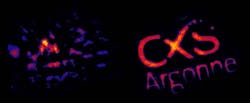Chicago, IL--A new form of x-ray coherent diffractive imaging (CDI), called polyCDI, has been developed that cuts exposure time by 60X, making the technique more practical for imaging nanostructures in great detail.
X-ray coherent diffractive imaging (CDI) is a form of lensless imaging that allows scientists to view the interior of nanocrystals and biological cells. One problem, though: CDI is monochromatic. This means that a bright polychromatic x-ray source, such as the Advanced Photon Source (APS) at the Argonne National Laboratory, has to be filtered (with a monochromator and pinhole spatial filter) to create a quasi-monochromatic beam. As a result, brightness is cut way down and exposure time skyrockets.
60X improvement in exposure time
A group of American and Australian scientists has solved this problem, developing a technique called polyCDI that cuts exposure times by a factor of 60.1 In polyCDI, prior knowledge of the light source's polychromatic power spectrum is taken into account in the image reconstruction. The researchers are from the ARC Centre of Excellence for Coherent X-ray Science (The University of Melbourne and La Trobe University), SLAC National Accelerator Laboratory, and Argonne National Laboratory. They used the Argonne X-ray Science Division (XSD) 2-ID-B x-ray beamline at the APS.
Used in concert with a new generation of fast x-ray detectors, CDI could make possible the first time-resolved nanomovies of changes to materials brought on by extreme temperatures or high magnetic fields, processes that are vital in developing advanced materials for new technologies. Coupled to innovative focusing optics, polyCDI could greatly reduce the time needed to gather information about the composition of diseased cells.
"Typically for best imaging, researchers need to convert samples to crystals, but this is not always possible in all samples," said Keith Nugent of the University of Melbourne and a member of the polyCDI team. "This discovery of utilizing full-color synchrotron light to improve precision and speed of imaging has huge potential."
REFERENCE:
1. Brian Abbey et al., Nature Photonics 5, 420 (published online July 2011); DOI: 10.1038/NPHOTON.2011.125.
Subscribe now to Laser Focus World magazine; it's free!

